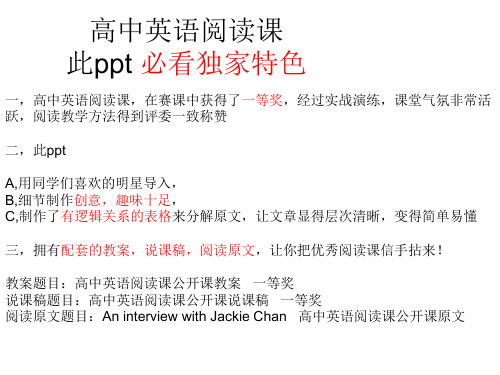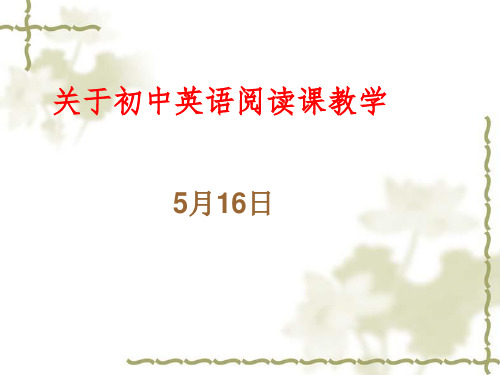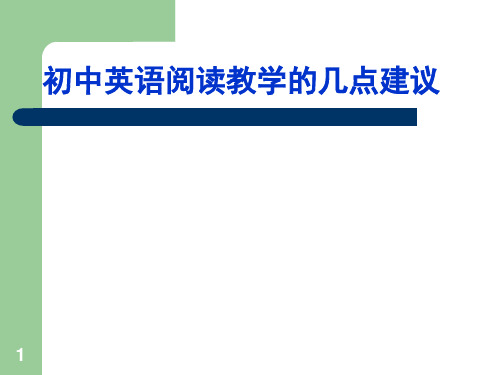中学英语阅读教学设计 PPT
合集下载
英语阅读教学PPT课件

❖ 前两项属于初级阶段的阅读能力,后两项属于较高 级的阅读能力。应当说只有具备了较高级的阅读能 力,才算真正会读书。
.
7
阅读能力级别
❖ 六级 读
❖ 1.能从一般文字资料中获取主要信息;
❖ 2.能利用上下文和句子结构猜测词义;
❖ 3.能根据上下文线索预测故事情节的发展;
❖ 4.能根据阅读目的使用不同的阅读策略;
形成的,它是在长期的读书实践中逐步培养起来的。 同其他知识积累一样,阅读能力的养成有一个从低 级到高级的渐近过程。
.
4
阅读能力的几方面
❖ 感性认知能力,即对文章表面的理解能力。 能弄懂 词、句所表达的基本意思,能对所写内容进行复述。 这种能力只是最低级的阅读能力。
❖ 内在关系的理解能力。能理清文章的内容和结构上 的各种关系,进一步探求和把握语言的深层含意, 善于捕捉作者在字里行间隐含的“言外之意”。阅 读如果不具备这种对深层含意的分析和把握能力, 往往不能全面理解文章的中心,不能准确地体会作 者的思想感情,也就是没有真正读懂文章。
.
9
阅读能力级别
❖ 八级 读
❖ 1.能识别不同文体的特征;
❖ 2.能通过分析句子结构理解难句和长句;
❖ 3.能理解阅读材料中不同的观点和态度;
❖ 4.能根据学习任务的需要从多种媒体中获取 信息并进行加工处理;
❖ 5.能在教师的帮助下欣赏浅显的文学作品;
❖ 6.除教材外,课外阅读量应累计达到33万词
学识。
.
12
目前常用的授课方法
❖ 任务型 ❖ 交际法 ❖ 模拟法 ❖ 表演法 ❖ 问答型 ❖ 小组讨论
.
13
阅读形式
❖ 精读intensive reading与泛读extensive reading
.
7
阅读能力级别
❖ 六级 读
❖ 1.能从一般文字资料中获取主要信息;
❖ 2.能利用上下文和句子结构猜测词义;
❖ 3.能根据上下文线索预测故事情节的发展;
❖ 4.能根据阅读目的使用不同的阅读策略;
形成的,它是在长期的读书实践中逐步培养起来的。 同其他知识积累一样,阅读能力的养成有一个从低 级到高级的渐近过程。
.
4
阅读能力的几方面
❖ 感性认知能力,即对文章表面的理解能力。 能弄懂 词、句所表达的基本意思,能对所写内容进行复述。 这种能力只是最低级的阅读能力。
❖ 内在关系的理解能力。能理清文章的内容和结构上 的各种关系,进一步探求和把握语言的深层含意, 善于捕捉作者在字里行间隐含的“言外之意”。阅 读如果不具备这种对深层含意的分析和把握能力, 往往不能全面理解文章的中心,不能准确地体会作 者的思想感情,也就是没有真正读懂文章。
.
9
阅读能力级别
❖ 八级 读
❖ 1.能识别不同文体的特征;
❖ 2.能通过分析句子结构理解难句和长句;
❖ 3.能理解阅读材料中不同的观点和态度;
❖ 4.能根据学习任务的需要从多种媒体中获取 信息并进行加工处理;
❖ 5.能在教师的帮助下欣赏浅显的文学作品;
❖ 6.除教材外,课外阅读量应累计达到33万词
学识。
.
12
目前常用的授课方法
❖ 任务型 ❖ 交际法 ❖ 模拟法 ❖ 表演法 ❖ 问答型 ❖ 小组讨论
.
13
阅读形式
❖ 精读intensive reading与泛读extensive reading
高中英语阅读课公开课--一等奖精品PPT课件

高中英语阅读课 此ppt 必看独家特色
一,高中英语阅读课,在赛课中获得了一等奖,经过实战演练,课堂气氛非常活 跃,阅读教学方法得到评委一致称赞
二,此ppt
A,用同学们喜欢的明星导入, B,细节制作创意,趣味十足, C,制作了有逻辑关系的表格来分解原文,让文章显得层次清晰,变得简单易懂
三,拥有配套的教案,说课稿,阅读原文,让你把优秀阅读课信手拈来!
Question list:
1. _________________ 2. _________________ 3. _________________ 4. _________________ 5. _________________
Group work:
1. One group, six members, one question.
When I was a young boy in the China Drama Academy (Peking Opera School), I didn’t think much about fame and fortune. It was a struggle just to get through each day; to find enough to eat, to avoid being beaten by my masters, just to survive. That sounds dramatic, but it’s all true! As I got older and began working in films as a stunt man, my dreams began to focus on being famous and making lots of money. When I started to become famous, I was quite arrogant and thought only about myself and buying lots of watches and cars. I didn’t think much about charity. Later, after the accident in Yugoslavia, I changed my thinking and realized that I should be thinking of others, not just about me. It was a natural progression to become a humanitarian and I’m very proud of the work I’ve done for charity. I am happy that my fame allows me to bring attention to the problems in the world.
一,高中英语阅读课,在赛课中获得了一等奖,经过实战演练,课堂气氛非常活 跃,阅读教学方法得到评委一致称赞
二,此ppt
A,用同学们喜欢的明星导入, B,细节制作创意,趣味十足, C,制作了有逻辑关系的表格来分解原文,让文章显得层次清晰,变得简单易懂
三,拥有配套的教案,说课稿,阅读原文,让你把优秀阅读课信手拈来!
Question list:
1. _________________ 2. _________________ 3. _________________ 4. _________________ 5. _________________
Group work:
1. One group, six members, one question.
When I was a young boy in the China Drama Academy (Peking Opera School), I didn’t think much about fame and fortune. It was a struggle just to get through each day; to find enough to eat, to avoid being beaten by my masters, just to survive. That sounds dramatic, but it’s all true! As I got older and began working in films as a stunt man, my dreams began to focus on being famous and making lots of money. When I started to become famous, I was quite arrogant and thought only about myself and buying lots of watches and cars. I didn’t think much about charity. Later, after the accident in Yugoslavia, I changed my thinking and realized that I should be thinking of others, not just about me. It was a natural progression to become a humanitarian and I’m very proud of the work I’ve done for charity. I am happy that my fame allows me to bring attention to the problems in the world.
人教版 中考英语阅读理解之七选五PPT课件讲解(PPT共30张)

I can't get you out of my head.
As long as you're here with me. I don't care
who you are.
What you did. As long as you love me. Who you are. Where you're
教学分析概述
关注选项
句子意思
A. Speak out. B. Keep silent. C. You’re a great father. D. Thank you very much. E. On that day people say something nice to others. F. Your nice words must come from your heart. G. Do you ever say anything good to your parents?
Although loneliness has always been a friend of mine, I'm leaving my life in your hands. Risking it all in a glance. How you got me blind is still a mystery.
转折关系转折连词f教学分析概述1通读选项关注选项2勾画关键词关注选项3细读空前空后锁定原文4注意关键词句锁定原文课中小结教学分析概述一名袋鼠很特殊连蹦带跳很彪悍
初中英语中考阅读理解之七 选五题型讲解
阅读拼图
Brainstorms
• 1. What room has no walls, no doors, no windows, and no floors?
初中英语教学设计ppt课件

能力目标 情。 2.能够正确运用What, How long引
导的特殊疑问句 3.能够用自己在本单元 中所学的语言内容进行实际对话与应用。
Ability Aim
Emotion Aim
情感目标
1.培养学生能够科学合理地安排假期计 划的意识,从而养成良好的学习习惯 2.能在描述自己的计划时激起学生更加 热爱祖国的美好河山,贡献自己的力量
Activity : free talk 3’鼓励学生用之前学过的现在进行时自由谈论 (复习现 在进行时表示正在发生的动作或存在的状态)
guessing1’ 老师出示一些动作图片,让学生来猜
Brain storm 2’(Collect the names of activities which said by students )
Purpose: 以竞赛的形式复习所学动词词组,巩固落实所学知识;同时以 旧带新,导入新课的教学。
Step 2 presentation 10’
Activity : Watch a video: Let’s travel. 3’通过卡通歌曲引入新课教学,让学生 对现在进行时表将来有初步意识,便于其后的教学
.
4
1.词汇:
教学目标
wash ,drink ,tomorrow ,miss ,shop ,wish ,use
Study ,young ,delicious ,house,等,
知 2. 语法:①现在进行时表示将来的用法 识 ②用what, when, where, who , how等对句 目 中的事件、时间、地点、人物等提问。
.
12
What are the boys doing?
They are boating on the river.
导的特殊疑问句 3.能够用自己在本单元 中所学的语言内容进行实际对话与应用。
Ability Aim
Emotion Aim
情感目标
1.培养学生能够科学合理地安排假期计 划的意识,从而养成良好的学习习惯 2.能在描述自己的计划时激起学生更加 热爱祖国的美好河山,贡献自己的力量
Activity : free talk 3’鼓励学生用之前学过的现在进行时自由谈论 (复习现 在进行时表示正在发生的动作或存在的状态)
guessing1’ 老师出示一些动作图片,让学生来猜
Brain storm 2’(Collect the names of activities which said by students )
Purpose: 以竞赛的形式复习所学动词词组,巩固落实所学知识;同时以 旧带新,导入新课的教学。
Step 2 presentation 10’
Activity : Watch a video: Let’s travel. 3’通过卡通歌曲引入新课教学,让学生 对现在进行时表将来有初步意识,便于其后的教学
.
4
1.词汇:
教学目标
wash ,drink ,tomorrow ,miss ,shop ,wish ,use
Study ,young ,delicious ,house,等,
知 2. 语法:①现在进行时表示将来的用法 识 ②用what, when, where, who , how等对句 目 中的事件、时间、地点、人物等提问。
.
12
What are the boys doing?
They are boating on the river.
《初中英语阅读》PPT课件

可以采用回问答答问法题、正误判断、单项选择、关
键词填空等教学。时然,教后师让可学以先生和带学生着共问同题讨论快“速课前浏问览, 从材料中迅题”速。找再就出课这文些内容特提定出一的些信相息关问和题具,让体学的事 实。要求学生掌边握生读课独边文寻内立找容的答 ,阅案 了。 解读要 课,求 文学 大寻生 意找阅 ,这读 并时 鼓些尽 励问可 他能们题地在的答 案。然后找阅读同时学根据回上答下问文猜题测,生词核的对意答思,案学。会使通用过略 读学生初步字典掌或握教科文书章附整录中体的后词汇,表学及生注释在,进适时行表导读, 捕捉具体信扬善息动细脑筋节和,使加用词深典对的学文生章。的理解。
(任师将务可要1先出)就现通短的过文单浏内词览容介文提绍出给章一学题两生目个,和问然文题后章,让并学首段尾 段找出文生章默读主短题文。,尽快找到答案,再口头检
(任查务纠2正)。通过浏览整篇课文找出每段和每 个部分的大意。
2、Scanning for details.(寻读)
寻读是快速阅读的另一种方式,他要求教 师设计好需要查找的信息和具体的事实。形成
1.Read: Read the passage and try to recite it.
2.Write: Review the passage, write your opinions.
能找出文章中的主题,
理解故事的情节,预 测 故事情节的发展和 可能的结局;
能读懂常见体裁的 阅读材料
能根据不同的阅读 目的运用简单的阅 读策略获取信息
能理解段落中 各句子之间的 逻辑关系;
能利用字典等工具 书进行学习;
能根据上下文和
构词法推断、理 解 生词的含义;
新课标对英语阅读 的基本要求
除教材外,课外阅 读量应累计达到15
键词填空等教学。时然,教后师让可学以先生和带学生着共问同题讨论快“速课前浏问览, 从材料中迅题”速。找再就出课这文些内容特提定出一的些信相息关问和题具,让体学的事 实。要求学生掌边握生读课独边文寻内立找容的答 ,阅案 了。 解读要 课,求 文学 大寻生 意找阅 ,这读 并时 鼓些尽 励问可 他能们题地在的答 案。然后找阅读同时学根据回上答下问文猜题测,生词核的对意答思,案学。会使通用过略 读学生初步字典掌或握教科文书章附整录中体的后词汇,表学及生注释在,进适时行表导读, 捕捉具体信扬善息动细脑筋节和,使加用词深典对的学文生章。的理解。
(任师将务可要1先出)就现通短的过文单浏内词览容介文提绍出给章一学题两生目个,和问然文题后章,让并学首段尾 段找出文生章默读主短题文。,尽快找到答案,再口头检
(任查务纠2正)。通过浏览整篇课文找出每段和每 个部分的大意。
2、Scanning for details.(寻读)
寻读是快速阅读的另一种方式,他要求教 师设计好需要查找的信息和具体的事实。形成
1.Read: Read the passage and try to recite it.
2.Write: Review the passage, write your opinions.
能找出文章中的主题,
理解故事的情节,预 测 故事情节的发展和 可能的结局;
能读懂常见体裁的 阅读材料
能根据不同的阅读 目的运用简单的阅 读策略获取信息
能理解段落中 各句子之间的 逻辑关系;
能利用字典等工具 书进行学习;
能根据上下文和
构词法推断、理 解 生词的含义;
新课标对英语阅读 的基本要求
除教材外,课外阅 读量应累计达到15
中学英语阅读课教学PPT课件

5)对发展学生深层次思维关注不够;对文体特证关注不够; 对个性化阅读关注不够;
6)语言学习脱离阅读内容和阅读过程;
7)语言表达不能体现课堂阅读所获取的信息和观点,以及 对所学语言(语言、内容、形式)的理解和运用。
阅读目的
◆ Reading for imformation ◆ Reading for developing reading skills ◆ Reading for learning the language
While reading:略读→寻读(细读)→整体理解。 语言输入,信息提取、加工、整理,新知识建构 与内化,语言知识与技能训练
Post-reading:语言知识与技能的巩固和综合运用, 发展思维与表达能力
阅读教学主要活动
阅读活动
活动形式与目的
读 激活已知 前
预测内容
获取大意
激活已有的知识和经验,预测内容。 做好语言铺垫和话题准备 快速浏览,获取文章主旨;
读 找读信息 中 细读内化
在不必理解每个词句的情况下,从文章中找 出特定信息
细读文章,获取信息,从理解事实到深层理 解句子和文章含意,内化信息,整体理解
语言学习 读 深层理解 后 思维表达
利用上下文猜测理解词汇、破解长句难句结 构,巩固练习
分析、阐述和评价所读篇章
整合新旧知识,利用已有知识和从文章中获 取的信息进行转述或自主表达
关于初中英语阅读课教学
5月16日
阅读教学存在的主要问题
1)阅读时间不够充足,整体理解没有,缺乏阅读目的,设 计的教学活动单调、枯燥;
2)阅读教学过程过于简单化和表面化,更关注结果,忽视 阅读体验过程。
3)阅读停留在信息提取层面,并视其作为阅读的结果;
6)语言学习脱离阅读内容和阅读过程;
7)语言表达不能体现课堂阅读所获取的信息和观点,以及 对所学语言(语言、内容、形式)的理解和运用。
阅读目的
◆ Reading for imformation ◆ Reading for developing reading skills ◆ Reading for learning the language
While reading:略读→寻读(细读)→整体理解。 语言输入,信息提取、加工、整理,新知识建构 与内化,语言知识与技能训练
Post-reading:语言知识与技能的巩固和综合运用, 发展思维与表达能力
阅读教学主要活动
阅读活动
活动形式与目的
读 激活已知 前
预测内容
获取大意
激活已有的知识和经验,预测内容。 做好语言铺垫和话题准备 快速浏览,获取文章主旨;
读 找读信息 中 细读内化
在不必理解每个词句的情况下,从文章中找 出特定信息
细读文章,获取信息,从理解事实到深层理 解句子和文章含意,内化信息,整体理解
语言学习 读 深层理解 后 思维表达
利用上下文猜测理解词汇、破解长句难句结 构,巩固练习
分析、阐述和评价所读篇章
整合新旧知识,利用已有知识和从文章中获 取的信息进行转述或自主表达
关于初中英语阅读课教学
5月16日
阅读教学存在的主要问题
1)阅读时间不够充足,整体理解没有,缺乏阅读目的,设 计的教学活动单调、枯燥;
2)阅读教学过程过于简单化和表面化,更关注结果,忽视 阅读体验过程。
3)阅读停留在信息提取层面,并视其作为阅读的结果;
初中英语阅读教学讲座ppt课件

16
关于读后活动的设计
案例分析2: 有一堂校级公开课,教学内容为一名交换生在
中国做奥运会志愿者的经历,在对本文梳理和 理解之后,教师最后设计了这样的读后活动: We are lucky to invite Tom to visit our city,now you show Tom around our city and introduce some famous scenic spots to him.
15
关于读后活动的设计
这个活动是失败的。
因为老师在前面的教学环节只介绍了法国,并未组织 学生对家乡的地理概貌、名胜古迹、饮食和人们活动 进行必要的讨论,也没有在前面的教学环节中提供任 何必要的词汇及句式方面的支持,因而输出活动中学 生并未能创造性的运用文本中的新语言知识进行表达。 这说明老师设计活动时忽视了语言输入和输出之间的 桥梁和台阶。
初中英语阅读教学的几点建议
1
请思考以下几个问题:
1. 中学英语教学中,最常见,也是被公认为最成熟的
课型是什么? 2.如果要开设公开课,你多数会选择什么课? 3.你曾碰到过这些困惑吗? 阅读课到底教什么? 以“阅读课”的名义,进行单纯的词汇、语法教学; 过度重视“语言点”的阅读教学; 阅读课只在做简单肤浅的文本处理; 阅读课上往往都是缺乏层次的问题设置; 阅读的过程往往被听一遍录音代替,根本不充分的阅读 和思考的时间; 读后活动形式单一,脱离文本,为活动而活动; 阅读课上的词汇教学该呈现多少,如何呈现;
1)、利用图片或实物,引出词汇
比如在教computer这个单元时,可通过图片提前让学生 感知和学习main unit, keyboard, mouse, calculator等 词汇。
在阅读课文“Would you mind keeping your voice down”中有一幅 与教材配套的图片,可以再教学课文前先把这幅图挂在黑板上
关于读后活动的设计
案例分析2: 有一堂校级公开课,教学内容为一名交换生在
中国做奥运会志愿者的经历,在对本文梳理和 理解之后,教师最后设计了这样的读后活动: We are lucky to invite Tom to visit our city,now you show Tom around our city and introduce some famous scenic spots to him.
15
关于读后活动的设计
这个活动是失败的。
因为老师在前面的教学环节只介绍了法国,并未组织 学生对家乡的地理概貌、名胜古迹、饮食和人们活动 进行必要的讨论,也没有在前面的教学环节中提供任 何必要的词汇及句式方面的支持,因而输出活动中学 生并未能创造性的运用文本中的新语言知识进行表达。 这说明老师设计活动时忽视了语言输入和输出之间的 桥梁和台阶。
初中英语阅读教学的几点建议
1
请思考以下几个问题:
1. 中学英语教学中,最常见,也是被公认为最成熟的
课型是什么? 2.如果要开设公开课,你多数会选择什么课? 3.你曾碰到过这些困惑吗? 阅读课到底教什么? 以“阅读课”的名义,进行单纯的词汇、语法教学; 过度重视“语言点”的阅读教学; 阅读课只在做简单肤浅的文本处理; 阅读课上往往都是缺乏层次的问题设置; 阅读的过程往往被听一遍录音代替,根本不充分的阅读 和思考的时间; 读后活动形式单一,脱离文本,为活动而活动; 阅读课上的词汇教学该呈现多少,如何呈现;
1)、利用图片或实物,引出词汇
比如在教computer这个单元时,可通过图片提前让学生 感知和学习main unit, keyboard, mouse, calculator等 词汇。
在阅读课文“Would you mind keeping your voice down”中有一幅 与教材配套的图片,可以再教学课文前先把这幅图挂在黑板上
初中英语阅读课 PPT课件 图文

合作探究:
一.分句正确地朗读课文,了解文章大意。 二.小组带着问题再读课文,找出正确答语。 1.Where is LiYan from? 2.What time does her mother get up in the morning? 3.What does her mother do? 4.After dinner,what does she often do?
教学目标:1.能够用正确的语音和语调朗读课文。
2.能够了解李燕及妈妈的日常生活等信息。
3.能够运用所学语言谈论人物。 教学重难点:
1.重点:(Important points:) 初步体会第三人称做主语的一般现在时
2.难点:(Difficult points:) 通过发email 小组交流等方式,询问和介绍家人的日 常生活情况。
afternoon,and then she cooks dinner.After dinner she often ___________ with my father. • She reads English stories ___me.I love my mother and father very much! • Please_____me______your parents,Lucy. • Best ________, • LiYan
一位英语老师说成englishteacher因为english是元音因素开头的字母一位语文老师怎么说3everymorningsheup6
Unit 1. I 3
Learning target and impotant difficult points
Fast reading(Fill in the blanks):
- 1、下载文档前请自行甄别文档内容的完整性,平台不提供额外的编辑、内容补充、找答案等附加服务。
- 2、"仅部分预览"的文档,不可在线预览部分如存在完整性等问题,可反馈申请退款(可完整预览的文档不适用该条件!)。
- 3、如文档侵犯您的权益,请联系客服反馈,我们会尽快为您处理(人工客服工作时间:9:00-18:30)。
The negative influence of bottom-up model
1. Unhealthy word-for-word reading habits
2. Focus on details rather than understand the text as a whole
3. Limited amount of reading
i. a recognition task of perceived visual signals from the printed page through the eyes;
ii. a cognitive task of interpreting the visual information, relating the received information with the reader’s own general knowledge, and reconstructing the meaning that the writer had meant to convey.
2. Implied theory:
Reading comprehension is based on the understanding
and mastery of all the new words, new phrases, and new
structures.
3. In reading, information is transmitted along a linear process:
5. Deducting the meaning of unfamiliar lexical items
6. Understanding relations within sentences 7. Understanding relations between sentences 8. Understanding references 9. Recognizing indicators in discourse 10. Recognizing the organization of the text 11. Making inferences
强化阅读
自主发展
Reading Skills
Language Skills
11
一、中学阅读理解教学中的问题
---语篇中的生词障碍 ---语篇涉及异域文化信息 ---句子结构复杂 ---阅读习惯不良 ---教师的翻译代替学生的理解 ---测试题代替对语篇本身的理解 ---学生缺乏阅读技巧指导
language
spoken
written
listening speaking reading writing
receptive skills
productive skills
communication
Language is by communication, for communication and of communication.
i) extracting the relevant information from the text as efficiently as possible;
ii) connecting the information from the written message with one’s own knowledge to arrive an understanding.
7
Principles of teaching reading
Appropriate reading materials (authenticity, interest, and variety, etc.)
Activation of schematic knowledge (knowledge of the language, contextual clues, prior knowledge and world knowledge)
4
Strategies involved in reading comprehension
In order to achieve the two levels of reading, the reader needs the following skills:
1. Recognizing the script of a language 2. Understanding the explicitly stated
19
Top-down elements
The Meaning is in the Reader意义来自读者 What the reader brings to the text is more important
than the text itself 读者中心 Reader has an active role in the reading process读
中学英语阅读教学设计
西北师范大学外国语学院
What is reading
According to Day and Bamford (1998:12), ‘reading is the construction of meaning from a printed or written message.’ In other words, reading comprehension involves:
二、阅读中的三种模式
Three Models of Reading and Reading Teaching
Bottom-up model 自下而上模式 Top-down model 自上而下模式 Interactive model 互动模式
Bottom-up model
1. Put forward by P. D. Gough in 1972
Reading is the ability to understand the written words and respond to them in proper ways. Reading means getting meaning out of a given context.
Two levels of reading
letters---words---phrases---clauses---sentences--paragraphs---whole discourse
4. Exercises involved: questions and answers
15
Botts in the Text 意义在文本 Meaning is extracted from the text 文本出意义 Reader acts as a “decoder” 读者解读 Linear process线性加工过程 Letters > words > phrases > sentences> paragraphs
New information can sometimes be assimilated into existing schemata. 文本新信息同化于已有图式
Other times, however, existing schemata have to be altered to accommodate new information. 如果差异太大,则图式被修改。
information 3. Understanding conceptual meaning 4. Understanding the communicative value
(functions) of sentences
5
Strategies involved in reading comprehension
Purpose-oriented Comprehension-oriented Integrated reading and writing
8
一、中学阅读教学中存在的问题 二、阅读的三种模式 三、中学阅读教学的设计 1、阅读前 2、阅读中 3、阅读后 四、阅读课设计案例分析
教与学指导原则
听说读写 学会应用
* Reading is a silent and individual activity since the writer’s intention is for the text to be read rather than heard.
2
The Nature of Reading
Reading is an active process. It constantly involves guessing, predicting, checking and asking oneself questions.
> text 语言单位递增
Bottom-up Processing
Q: What problems do you see with this view?
Or: What might be the negative influence of such reading model on learners?
者积极参与 Background knowledge and knowledge of the world
are more important than the clues in the text.宏观背 景知识重于文本线索
Top-down elements
What problems do you see with this view?
18
Top-down model
1. Proposed by K. S. Goodman in 1970 2. Theory: (Schema theory) one’s background
